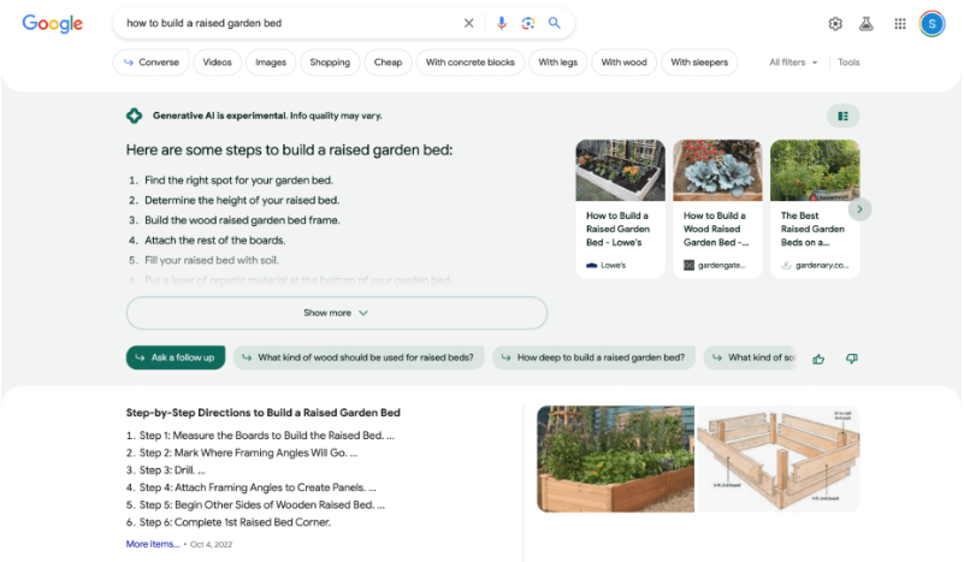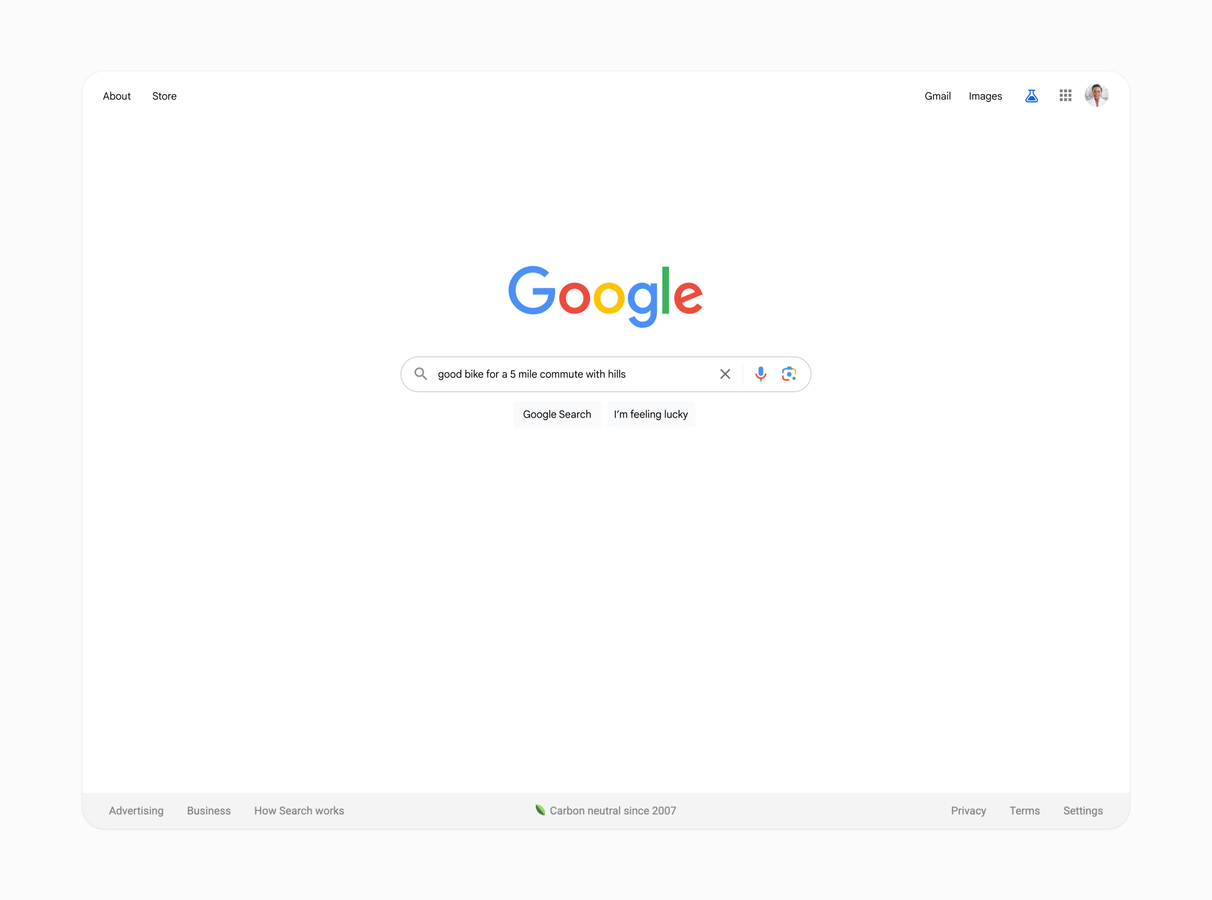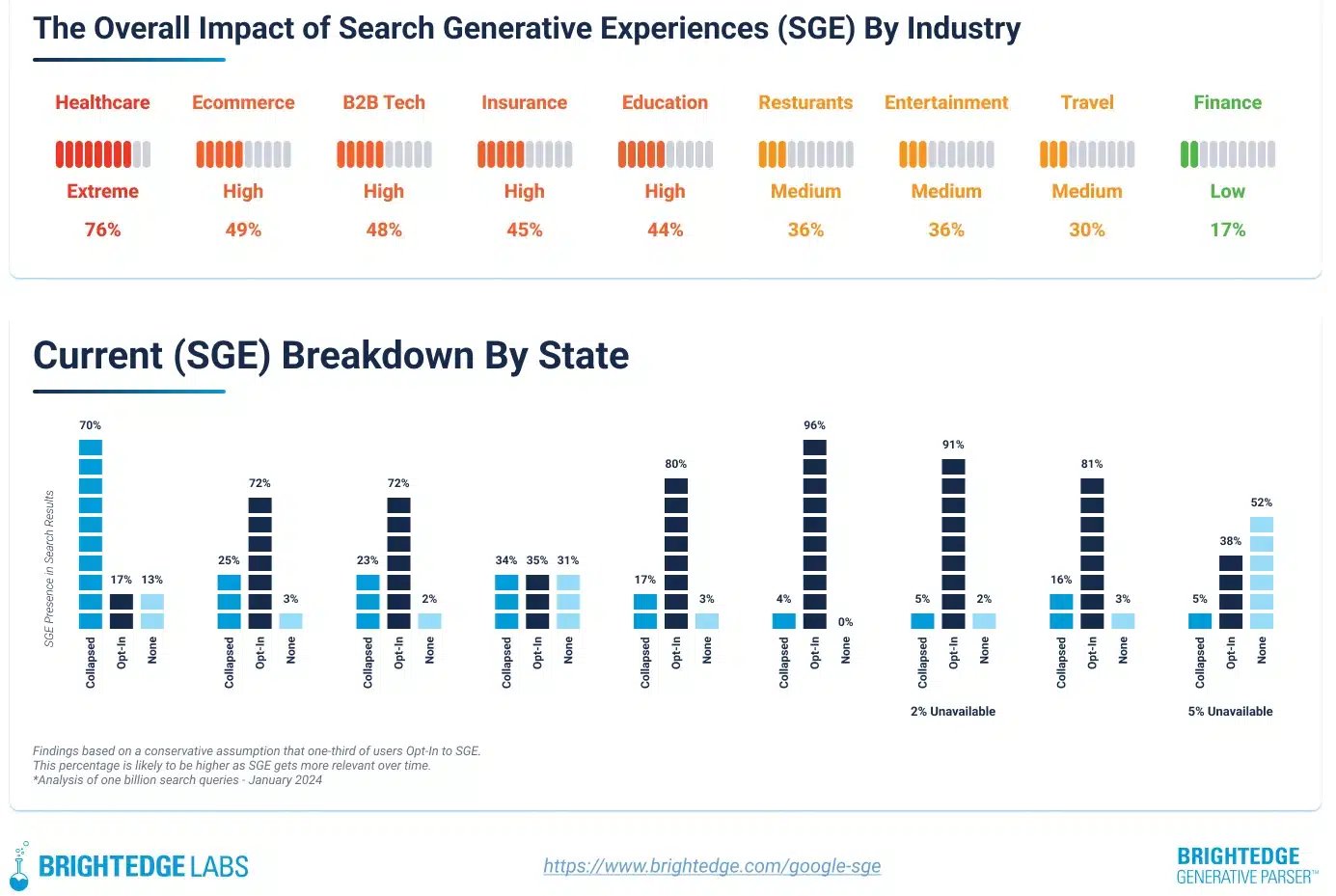
Google’s Search Generative Experience (SGE) is a new experimental feature which uses artificial intelligence to create contextual answers to complex questions. This aims to provide new and better defined answers, and bring new opinions and angles to existing queries.
SGE is still in its tentative early stages, and is being created to enhance the user search experience. When using SGE, users will see search results page similar to the ones they are used to, but organised in a new way to help them get more from a single search. In this blog, we explore what we know so far.
How does SGE impact on the user experience?
With SGE, users are able to:
- Ask new kinds of questions that are more complex and more descriptive and get a single answer return
- Get a general sense of a topic faster, with links to relevant results to explore further and learn more
- Get started on something they need to do quickly, like writing drafts or generating imagery
- Make progress in search and information gathering quickly and easily, by asking conversational follow-ups or trying SGE suggested next steps
How Search Generative Experience Works in Search
“With generative AI applied to Search, we can serve a wider range of information needs and answer new types of questions, including those that benefit from multiple perspectives.
We are surfacing more links with SGE and linking to a wider range of sources on the results page, creating new opportunities for content to be discovered.”
- Sundar Pichai, Google CEO

Source: Google
AI-powered overviews
When appropriate, SGE will show an AI-powered snapshot to help users get a fast overview on a topic, with further information to help them find out more if they so wish.
These snapshots serve as a springboard from which users can explore a wide range of content and perspectives on a given topic. SGE will offer links to sources that support or expand upon the information in the SGE snapshot, so users can check the information for themselves and explore further. This allows users the opportunity to discover a wider range of content, from publishers, businesses, charities, and more, and use that information to progress the task at hand or speed up processes.
Easier ways to follow up
Users can tap to ask follow up questions where they can refine what they’re looking for or explore a new direction without having to start again, or users can tap suggested next steps to discover relevant information or questions they may not have known to ask about in order to keep discovering new information. This will generate a new overview with additional links to resources to explore.
Asking follow up questions is especially useful for more complex or evolving information journeys. It uses AI to understand when a person is searching for something that is related to a previous question. It carries over context from previous questions to reformulate the query and better reflect the intent. In conversational mode, users will see their web links below SGE change throughout the course of the conversation so they can easily explore the most relevant content from across the web.

Source: Google
Vertical experiences
Generative AI will also be helpful for informational queries related to distinct verticals, such as location specific searches. These types of searches often have multiple dimensions to them. In shopping, for example, generative AI can help uncover key considerations and product information, so users can make purchase decisions faster and easier.
For product searches, generative AI will create a snapshot of noteworthy factors to consider and a range of product options. It may also provide reviews, prices, product images, and further relevant data. This up-to-date product information is possible because SGE is built on Google’s Shopping Graph, the world’s most comprehensive dataset of constantly changing products, sellers, brands, reviews, and inventory.
Search ads
Search ads will continue to play a critical role as SGE progresses. They serve as additional sources of useful information while helping users discover millions of businesses online.
With SGE, Search ads will continue to appear in dedicated ad slots throughout the page. In this new experience, advertisers will continue to have the opportunity to reach potential customers along their search journeys. Google will continue to test and evolve the ads experience as they learn more.
Google say they are committed to transparency and making ads distinguishable from organic search results. When Search ads do appear, they will continue to feature their industry-leading clear and transparent ad labels with the “Sponsored” label in bold black text.
Creativity and productivity
These new generative AI capabilities can help users continue their journeys in more creative ways, going beyond just finding information to making use of it. Google believe this has useful applications for users to carry out steps in their information journey, including those that require creativity.
While SGE is adept at both informational and creative applications, users will notice constraints on creative uses to start, as Google have intentionally placed a greater emphasis on safety and quality. Over time, Google will continue to expand creative capabilities as quality improves.
Image generation
Google have also introduced the ability to create images with the help of generative AI in SGE. Generative imagery is an interactive and fun way to visualise an idea or search for inspiration. You can ask questions like, “draw a picture of a capybara wearing a chef’s hat and cooking breakfast” and you’ll get up to four generated images to choose from. As part of this experiment, you may also see an option to get AI generated images directly in Google Images. Google’s hypothesis is that generative AI in Search can help spark inspiration and help you get even more done. Google look forward to continued testing and getting user feedback. The image generation capability is only available to users opted into the SGE experiment and who are 18 years or older, in English in the U.S.
User experience
Google say everything they do is grounded in extensive user research. They have been evolving the Search user interface (UI) for many years to be more useful, and more accessible.
The AI-powered snapshot has easy-to-access resources and recognisable UI for links that allow users to further explore across both desktop and mobile to bring the power of generative AI right into Google Search. Further, Google say they will help users make the transition to conversational follow-ups through thoughtfully crafted callouts and highlighted states that show the user how to use this new paradigm. For example, in conversational follow ups, a user can see how the AI stitches together the context of the query and its follow-ups to reformulate the AI-powered overview.
What We Know So Far
- Initially Google Search Generative Experience was a Search Labs experiment with a proposed end date of December 2023; this date has since been removed and Sundar Pichai (Google CEO) has indicated that search with generative AI is now one of Google’s top priorities
- Consumers show high levels of interest in AI powered search
- Consumers show high levels of trust in AI powered search
- A large proportion of new queries are commercially driven, so ads will play an important role in generative AI
- Google considers Bard (chat-based AI tool similar to ChatGPT) to be a complimentary product for SGE, running together to improve the user experience
- Over one-third of SGE results currently include local packs
- SGE is still experimental though it has moved beyond Search Labs, so how it works will continue to change
- Google appear to be prioritising high quality online sources using many of the signals they have been using in organic search for many years, emphasising the need for high quality content and a technically sound site
- Ecommerce queries for products will see a spike as products are prominently displayed in the AI overviews
- High quality, unique product images of your actual product will likely have a positive effect on clickthrough rate, just like a good thumbnail does on YouTube or attractive images in general on a website or advertisement
- For AI-shopping assistance, SGE offers Product Viewers for apparel and general products
What We Might Expect in 2024
SGE is likely to play an increasing part in Google search results. In the past, position zero (the featured snippet) was a snippet of information from the website Google deemed to offer the best information on the topic.
With SGE, Google’s AI parses different sites to develop a single comprehensive answer to a search query. Unlike the featured snippet, this answer has links to the articles the AI engine pulled from to generate the SGE snapshot. Contrary to popular belief, this means SGE won’t steal your traffic. If anything, it’s giving publishers more ranking opportunities. So, instead of anticipating a drop in website traffic, marketers and content creators should look for ways to increase it by leveraging the ranking opportunities presented by Google’s generative AI.
Measuring Results
Tracking SGE performance is still largely unknown. Results do not appear to be included in Google Search Console yet and there hasn’t been any hint as to whether there will be reports in the future.
The use of AI-powered search engines or chatbots means we might need to evolve our KPIs as traditional ways of measuring performance and understanding the search market might become less effective. As users move towards ChatGPT like tools, metrics from common tools won’t cover the whole market as they don’t measure search on these tools which are currently completely opaque. This means we won’t be able to measure market size, competition, and visibility as we currently do.
Currently, there isn’t a satisfying answer to these problems, but we can use alternative methods where needed.
- Monitor the number of words per query by analysing paid search queries to establish whether users are turning more towards new conversational mode – the higher number of words per query, the more likely they are using a chatbot.
- Monitor your brand visibility in chatbots by manually asking questions and reviewing the answers (this could be scaled by using tools that allow us to upload data in bulk like Claude 2 for sheets or ChatGPT for sheets).
- Monitor rankings by manually reviewing SGE results – this would be highly time consuming.
- Monitor ChatGPT visits on your site by reviewing your log files – ChatGPT usually leaves behind a user agent when they search for answers on Bing which should show in your log files, indicating whether you’re appearing in an answer. You can track this using this WordPress plugin.
Who will be Most Impacted?
Although still in its experimentation phase, SGE is already showing an impact on various industries, particularly healthcare. Enterprise SEO platform BrightEdge analysed one billion queries across nine industries to see how they were affected. The results showed that 76% of queries for healthcare were affected, 49% for ecommerce, and 48% for B2B tech.
These results are somewhat surprising as most people thought healthcare wouldn't be as affected by AI given the potential negative impact wrong information can have on people. Ecommerce is less surprising though as Google have been pushing many changes recently in search results that affect this industry.

Source: Brightedge
What to Look Out For
Monitor your organic clickthrough rate. As SGE continues to expand, the top ten organic links are likely to be pushed down and a drop in CTR may be an indicator that this is happening.
Monitor your paid search performance. Typically, SGE is likely to mean more long tail search queries. This means better performance for broad match keywords, but also leaves you open to a large number of irrelevant and low-quality search terms which will need to be carefully monitored and excluded to stop budget waste.
How to Prepare for Increases in SGE – What You Can Do Now
- Use proper markup schema on text, image, and video content to ensure it appears in relevant AI responses.
- Always include citations/links to original sources.
- Prioritise reputation management and build a good online reputation with good reviews and positive user engagement through social media and other channels. Keep an eye out for negative reviews and be ready to combat them as they arise.
- Ensure all owned properties are accurate and up to date, such as Google Business Profiles, and your website.
- Ensure your site is technically healthy, with good website speed, mobile friendliness, good UX and Core Web Vitals.
- Add image extensions to ads and test Performance Max campaigns and shopping feeds if relevant.
- Create strong product copy including features and benefits, ensure this content is unique.
- Provide straightforward answers to common queries at the start of the piece.
- Offer detailed FAQs and in-depth content.
- Consider repurposing existing popular content into non-organic search assets such as podcasts, YT videos, whitepapers, and infographics.
How to Start Adapting to Google SGE and Generative AI Search Experiences – Long Term
As above, but also:
- Expect a shift towards more long-tail and conversational keywords and optimise for these.
- Aim for a diversity of content types to improve visibility and create in-depth content including internal links.
- Create helpful content that satisfies or exceeds E-E-A-T.
- Provide content which offers unique experiences and reflects human perspectives, use first person experiences at every opportunity.
- Diversify your traffic to prepare for a potential loss of organic search traffic with zero-click answers.
- Experiment with SGE. Test existing AI-powered search engines and assistants with your brand name, your products, and your customers' top questions. See what results you receive, and optimise your presence online accordingly.
The Future of SGE
While we cannot know the future of SGE, the following evolutions have been voiced as strong possibilities within the SEO community:
Enhanced personalisation: SGE is expected to become even more personalised. As algorithms improve, search engines will better understand individual preferences, providing users with highly tailored content and search results.
Voice search: Voice search is gaining prominence, and SGE will adapt to this trend. Content marketers will need to optimise content for voice queries, which often have a conversational tone and longer queries.
Visual search: Visual search capabilities are evolving. SGE will likely incorporate visual recognition technology, allowing users to search for information by uploading images or using their device’s camera.
Current Known Limitations
While Google have built a range of protections into SGE, there are known limitations of both LLMs and this experience in its initial, experimental form. The following are some of the loss patterns that were observed during evaluations and adversarial testing, and other limitations Google expect in SGE. In many cases, they have already made improvements with model updates and additional fine-tuning, and they expect to make further progress as SGE develops.
- Misinterpretation during corroboration: Google have seen some instances where SGE has appropriately identified information to corroborate its snapshot, but with slight misinterpretations of language that change the meaning of the output.
- Hallucination: Like all LLM-based experiences, SGE may sometimes misrepresent facts or inaccurately identify insights.
- Bias: The data that SGE is trained on is based on high-quality web extracted data that can exhibit narrow representations of users or potentially negative contextual associations. Despite additional safety and bias prevention guardrails applied, some nuances of data patterns still seep through, and can lead to SGE producing biased results. This is a challenge that occurs in search results today. For example, authoritative media entities and data providers often do not add a qualifier of “men’s” when writing about men’s sports, and generic queries about that sport may thus bias towards men’s players or teams, even if information about women players or teams is an equally or perhaps even more accurate response. Google have been committed to making improvements to combat bias and recognise there is more work to be done.
- Opinionated content implying persona: While SGE is designed to reflect a neutral, objective tone in its generative output, there may be instances in which the output reflects opinions that exist on the web, giving the impression of the model displaying a persona.
- Duplication or contradiction: Because SGE is integrated into Search alongside existing search results, it’s possible for the output of SGE to appear to contradict other results which are returned for the same query. For example, users might see a featured snippet result that highlights the perspective of a single source, while SGE represents a synthesised perspective corroborated in a range of results.
Get Ready for SGE
The many changes brought by Google in 2023 will continue into 2024 and businesses need to evolve their SEO and digital marketing strategies to remain competitive. Although the core principles of SEO and marketing haven't changed, implementation and measurement of performance will need to evolve.
At Innovation Visual, our team of dedicated experts can help you navigate this ever-changing environment and adapt your strategy to keep winning. Contact us today to discuss your challenges and how we can help you be successful in an AI-powered search landscape.
Blog sources: Google, Google Labs, SEJ, SEL, SER, ClearVoice, StudioHawk, Barry Schwartz, BrightLocal







